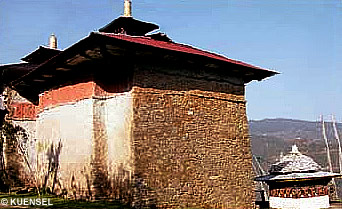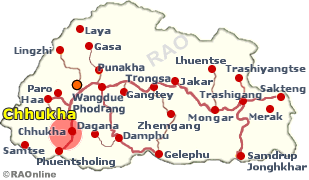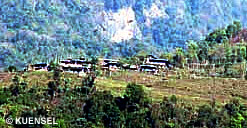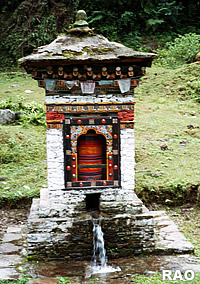 |
Bhutan's Religion Bon |
|
 |
Bhutan Information |
|
|
 |
| Chhukha
dzongkhag: The people of Bongo |
 |
The
people of Bongo, a remote village under Chhukha dzongkhag, are optimistic
that this year too, their crops will be bountiful, natural calamities will
be less and there will be no sickness in their village.
 |
| The
Bongo Lhakhang houses the two local female deities |
| The
villagers as usual, invoked their Yul-Lha (local deities) and believe
that their year round hard work would not go to waste.
A five-hour walk
from the nearest road head in Meritsemo, lies the village of Bongo where
'Bonism and Shamanism' which involves animal sacrifice is still
very much a part of daily life and are an integral part of the Bongop
(people of Bongo) culture. |
|
Every
year, the 52-households of Bongo come together twice a year and conduct
the invocation recital for good heath, to dispel misfortunes and to usher
a good harvest.
|
The
bonism is deeply rooted in Bongo village |
 |
 |
| The
invocation recitals of Yul-lha are the most auspicious annual event
in Bongo. It is observed during the 10th
day of the second and 10th month of the Bhutanese calendar.
It
is called Sochoed (spring ritual coinciding with the crop sowing season) and Serchoed (fall ritual coinciding with the harvest season and offering
of first harvest to the deities). |
|
Invocation
of deities and spirits begin at 5.00 in the morning and concludes three
hours later with the feast offering or animal sacrifice to their Yul-lha,
Am Yangtam and Yangchum (two sister deities) at the Neykhang located above the village.
During
the rituals people worship, offer Nyendar (cash offering) and pray
to the sister deities. A symbolic environmental cleansing through purification
rites of incense burning is done before invoking the deities. They also
summon other deities and spirits residing in mountains, valleys, lakes,
forests, streams and cliffs invoking them to assist and protect people
from misfortune, rivalry, contempt, ailments, epidemics and to ensure a
bountiful crop.
It
is not known when and how the tradition came to be. "It is an age old tradition
established by our ancestors and we should maintain it,"says 67 year-old
Bonpo Pema Wangchuk. "If we do not conduct the ritual, misfortune would
befall us and our crops would be destroyed."
 |
| Bongo
village where bonism is deeply rooted |
| Animal
sacrifices during public ceremonies like Sochoed and Serchoed are
usually small as compared to private ones where a large numbers of animals,
mostly poultry birds, are sacrificed to appease the local deities. Household
sacrifices are usually performed to cure sickness and drive away spirits. |
|
A Bonpo (a bon priest) who performs the ritual is entitled to a
portion of the animal sacrificed and seven 'dres' (one dre equals one
and half kilogramme) of grains from each house hold for conducting
the public ritual.
"Until
last year a village sacrificed about 300 poultry birds, pigs, goats and
bulls in a year,"Ap Phub Sithub, 75, said. But in recent years, the rituals
have undergone a change. The tradition of animal sacrifice (marchoed) during the invocation recitals has been discontinued following a kasho
(edict) issued by His Holiness the Je Khenpo. Today the local
people offer animal products like eggs and cheese known as karchoed.
The lam
of Bongo lhakhang, Pasang, said that offering of animal products had
replaced animal sacrifice in the seven villages of Bongo, Damji, Ketokha,
Toktokha, Jungley, Zamsa and Phasuma, all under Bongo geog,
where Marchoed was widely prevalent. "This has helped in saving
the lives of hundreds of animals,"says Lam Pasang who added that the people
were convinced that karchoed was a good substitute.
The
people were further convinced after the statues of the two female deities
were installed at the Bongo lhakhang where an invocation through the rolling
of the holy dice indicated that the deities were happy with the change.
"We
consulted the villagers and drew up an agreement to discourage killing,"
says Bongo gup, Nim Gyeltshen. A committee comprising the gup, chimi,
tshogpa members and the village lam was also formed to monitor slaughtering
of animals. According to the committee's rules, a violator will be fined
Nu. 5,000 and repeat violator would be charged to court.
| Prayer
Mill |
| The
practice of animal sacrifice still prevails in various regions around the
country. It is a sect of animistic shamanism, a pantheistic cult embracing
the belief that all beings in the universe have souls. It is believed that Bonism came to Bhutan from Tibet where it prevailed before the advent of Buddhism in the eighth century.
According
to a legend of Bonism, it was created by Tenpa Sherab, a
contemporary of Buddha, in a mystic region known as Tazi in Tibet.
The Bonism followers believed that at the very beginning of the
creation, there were two eggs, one white and one black. The two eggs burst
and from the white egg came out deities and humans and from the black egg
came out parasites, demons and spirits. |
|
 |
Although
animal sacrifice is being discouraged, the Bongops still continue
to sacrifice at least one animal a year. Each household slaughters a pig
during their annual ritual, Choesung that is performed to appease their protective deity, Gyem Mani Naap also known as Pekar.
"Meat
is indispensable to invoke our deity and it is not possible to cease practicing
this tradition,"says Tshering Dem, 50. For the sacrifice the Bongops select and identify a piglet which when in adulthood is sacrificed to appease
Pekar. "The pig offering should be clean,"says 70-year old Dorji from Zamsa.
"Normally we do not buy pigs from Phuentsholing because they are not clean."
In
Baikunza under Bongo geog, animal sacrifice is still rampant.
| Contributed
by Rinzin Wangchuk, Kuensel, Bhutan's National Newspaper |
 |
| Information on Bhutan |
 |
|





